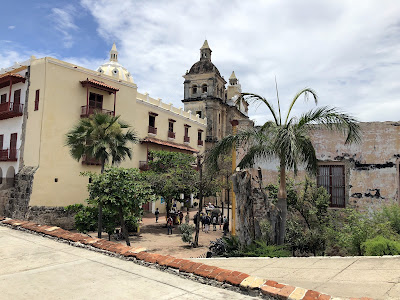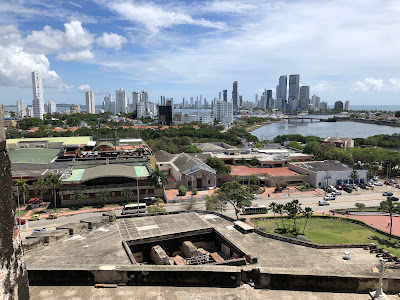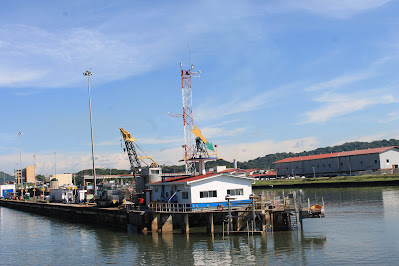I have always wanted to go through the Panama Canal so last October we decided to spend some of the money we had not spent during Covid and booked a three-week cruise on the Norwegian Encore. We disembarked from Miami on Easter Sunday and ended in Seattle on Mothers Day. There were nine scheduled stops in Columbia, Panama, Costa Rica, Guatemala, Mexico, USA and Canada. The rest of the days were spent at sea so we had plenty of time to enjoy the ship amenities, including the spa.
The Encore is the same ship we went on in February with John and Patrice. On that cruise there were about 1400 people on a ship built for over 4000. This time we left Miami with 2650 passengers. Most of those people got off in California so for the last few days there were less that 1000. Our first two days were at sea and the next three, covered in this post, are our stops in Cartagena, passing through the canal and a day in Panama City.
We had excursions scheduled for most of our ports. When we woke up in Cartagena it was raining, so we were not sure how our tour of San Felipe Fortress and the old walled city would go. The bus ride did not raise our expectations. As the clouds lifted, the plans changed to city first, fortress last.
The streets of the walled city are very narrow and crowded with cars, scooters and people. This is Santa Catalina de Alejandria Cathedral. Construction began in 1577 but it was heavily damaged when attacked by English privateer Francis Drake in 1586. It was completed in 1612.
Simon Bolivar Square. Bolivar was a Venezuelan leader who fought for independence from the Spanish Empire. The empire included Venezuela, Columbia, Ecuador, Panama, Peru and Bolivia. He is known as the Liberator of America.
This is San Pedro Claver Church. It was built between 1580 and 1654 in the Spanish colonial style. At the altar are the remains of Saint Peter Claver who died in 1654 after spending most of his life trying to convince Black slaves and indigenous people to follow the way of the church.
Looking into one of the many plazas inside the wall from the top of the wall that surrounds the city. Construction of the wall began after the attack by Drake and took nearly 200 years to complete.
The 11 kilometer wall is the most complete and preserved wall in South America. It is a World Cultural Heritage site.
The Clock Tower built into the wall of the city. When it was built in 1601 it was the connection to Old Cartagena via a draw bridge. It is an octagon so the clock could be visible from all points of the city.
Even with the wall, Cartagena still needed a fort to protect the city. We have toured many old forts during our travels but Fortress of San Felipe de Barajas is without a doubt the most impressive.
It was built in 1536 and was in several battles into the 19th century. It is built where it had a commanding view of the city and harbor. There are eight gun batteries, each designed to protect another battery. To get to the top attackers would have to navigate a maze of tunnels.
The view from 135 feet above sea level of New Cartagena, Boca Grande, beach front skyscrapers. The city has a great mix of well preserved past and new modern buildings.
Another look at the old and new.
On the way back to the ship we walked through an aviary. The noise was almost deafening as all the parrots were squawking. While this one was willing to sit on my hand, it did try to bit me.
Several peacocks were showing off their plumage.
This was the source of all the squawking. It was a great way to end our visit to Cartagena, seeing all these birds up close. We left that evening and sailed overnight to the entrance of the Panama Canal.
We were up early, 4:30 AM, on canal passage day. That still did not get us a front row seat in the Observation Lounge, but we had a great view. This boat is a tug that will accompany the Encore through the locks and canal. A canal pilot also comes aboard all ships. This bridge on the Atlantic side was built in 2019. It is the newest of three bridges that cross the canal.
The canal splits here with smaller ships going right to the original Gatun Locks and bigger ships going left into the new Agua Clara Locks that opened in 2016. The old locks can accommodate ships with up to a 110' beam and 1050' in length. The new locks handle ships up to 160' wide by 1200' long.

This car carrier Tarago heads to the old locks while we wait with the tug for our turn to go through the new locks. The Encore is both too wide and too long for the old locks.
We are still waiting our turn to enter the first of three locks in the Agua Clara complex. The toll for passage starts at $850 for the smallest boat. Large ships pay according to the size and weight of their cargo. The most ever paid to date is $1,200,000. The lowest toll was paid by Richard Halliburton who paid 36 cents to swim the entire length in 1928.
All the water to operate the locks comes from Gatun Lake. Gravity moves the water into and out of the locks. All the water ends up in the ocean. These ponds, part of the new locks, are used to recycle about 60% of the water.
The container ship in front of us has moved into the second of the three locks.
The new locks use rolling rather then swinging gates. The water in this lock is now at sea level so we can enter. All modern big ships have side thrusters, that control side to side movement, so "mules" are no longer needed to guide them into and out of the locks.
The passage drew a big crowd. In addition to this lounge, the bow deck was open. We could also watch from our balcony or other decks.
There is also a railroad across the 51 mile isthmus. In some cases it costs less to unload the containers from a ship, load them onto the train and then onto another ship on the other side, than it costs to transport it through the canal.
While we wait our turn, the ship in front of us sails into Gatun Lake 85' above sea level. The elevation of the lake varies from 82 to 87' depending on the amount of rain. The scale of the whole thing is hard to comprehend. This lock is 1200' long and 160' wide.
Panama Canal is very different from any other canal we have seen or been through. Once you leave the lock, for most of the 40 miles to the next lock you are sailing across a big lake not through a channel.
The dredging equipment that is still used on the canal is in Gamboa where the Chagres River flows into the canal. Titan, the huge floating crane, was originally built in 1941 in Germany. After WWII the US brought it to Long Beach shipyard. When it closed it was sold to Panama. Today it is usually called Herman the German.
From Gamboa we entered the nearly eight mile long Culebra Cut where we crossed the Continental Divide. This was the most difficult section of construction and its completion was considered one of the greatest engineering achievements of its time. The cut was started by the French in 1881 with plans to build a sea level canal. When the French gave up they had only lowered the summit from 210' above sea level to 193'.
When the US took over construction the plan changed to a canal with locks. This still required lowering the summit from 193' to 39' above sea level. They also widened the bottom of the cut from the French planned 72' to 299'. The work on this section lasted until nearly the day the canal opened in 1914.
Even with removal of 100,000,000 cubic yards of material, landslides were a major problem. The slide increased the amount of material removed by nearly 25%. Guess what? Landslides continue to be an issue today. You can't see them but they are working with heavy equipment even today to control the slides.
The Centennial Bridge was built in 2004 as a celebration of the 100th anniversary of the canal. The story is, the president of Panama wanted this bridge done even though there were no roads connected to it when the celebration took place.
After going down through the new Cocoli Locks on the Pacific side, we arrived in Panama City. We had to wait just outside the locks for low tide so the Encore could fit under the Bridge of the Americas.
The next morning we took an excursion in a smaller boat back into the canal up through the old Miraflores Locks. The skyline of skyscrapers in Panama City is very impressive.
Like all boats and ships entering the canal we picked up a pilot to guide us safely through the locks.
The Bridge of the Americas was the first built across the canal in 1962. This bridge is scheduled to be replaced because newer, higher ships cannot get under it. As I said, the Encore had to wait for low tide to clear it. On this side of the canal the tidal difference is nearly 20', while on the Atlantic side it is only three feet.
Check out the blue and yellow arrow. That tells the ship which of the two locks they will be using. So much for modern technology.
Ships in the old locks must drop a line to tie to the mules that guide them through. More modern technology, two guys in a row boat fetch the line.
We had to wait quite a while for tankers ahead of us to clear the first lock. The gates are starting to open for us. The ship on the right passed us and was raised in the first lock before we entered our lock. Here is a short video of the mule connected to that ship.
We are entering the lock. All of this is original construction from the early 1900's when the locks were built. The swing gates were manufactured in Pittsburgh.They do leak some water, that is why they used rolling gates in the new locks. Here is a video of our boat entering the lock.
Up close and personal with the 100 plus, year old lock wall. Special concrete that lasts better in the water was used.
A good look at how high we were going to be raised up to get to the next level. The water comes in through vents in the bottom of the lock. While the water coming in looks like it is boiling, the boat rose very smoothly.
We went through the locks with three tug boats. These tugs not only help guide the ships through the canal, they are also equipped to be fire boats.
One of the tugs we went through the locks with was practicing fire fighting. They first gave an international distress call of seven short and one long blasts of the horn signaling a ship in distress. As you can see a single tug puts out a lot of water.
Mules lined up waiting for ships to arrive that had entered the canal on the Atlantic side that morning. Because the newest ships have side thrusters the mules don't really pull them, they are only there for emergencies.
One of the tugs passing us and a big container ship that just come through the new locks in the background.
We started to meet Pacific bound ships that had entered the canal that morning. The excursion took us back under the Centennial Bridge to Gamboa where we boarded a bus back to Panama City.
A couple more ships heading to the Pacific. There were also a couple sailboats and yachts heading the same way. Doing the Panama Canal has been on my bucket list a long time and I must say it was everything I expected and more. Seeing huge ships towering above you is amazing. It gives you a whole new respect for the people who designed and built this engineering marvel 120 years ago that is stilling working as they had planned.
We still have many more tales to tell of our cruise that will be coming in the next few weeks.

















































2 comments:
Thank you so much for sharing this. It definitely ignites my wanderlust. Beautiful pictures, summaries and videos. I can understand why it was a bucket list thing. I may have to add it to mine!
Wow, what a trip through the locks! Thanks for the lesson! Great post.
Post a Comment